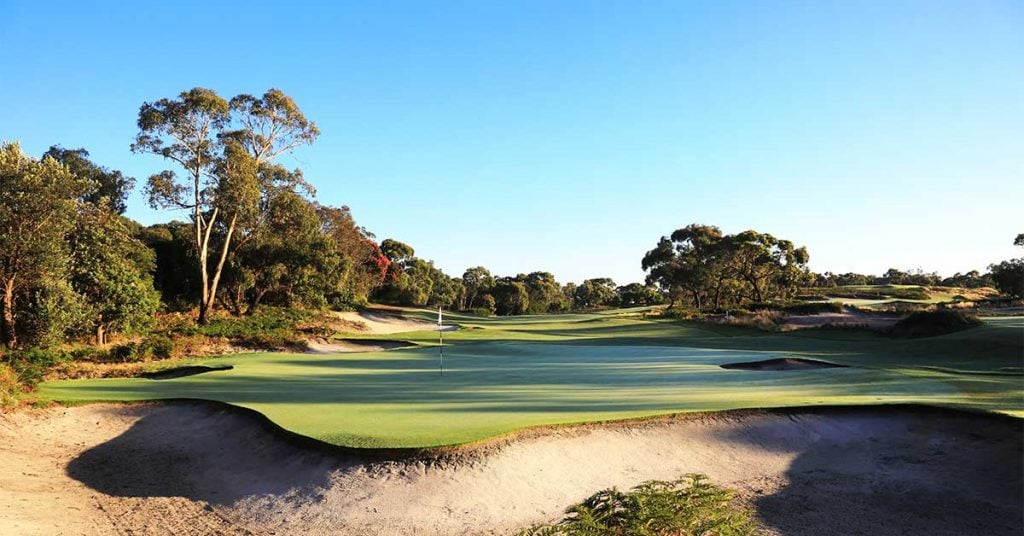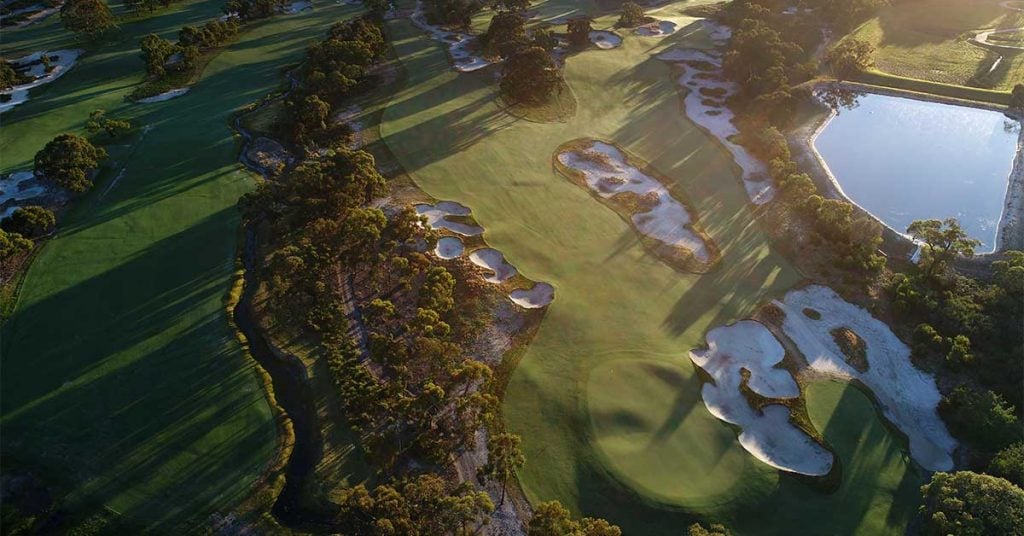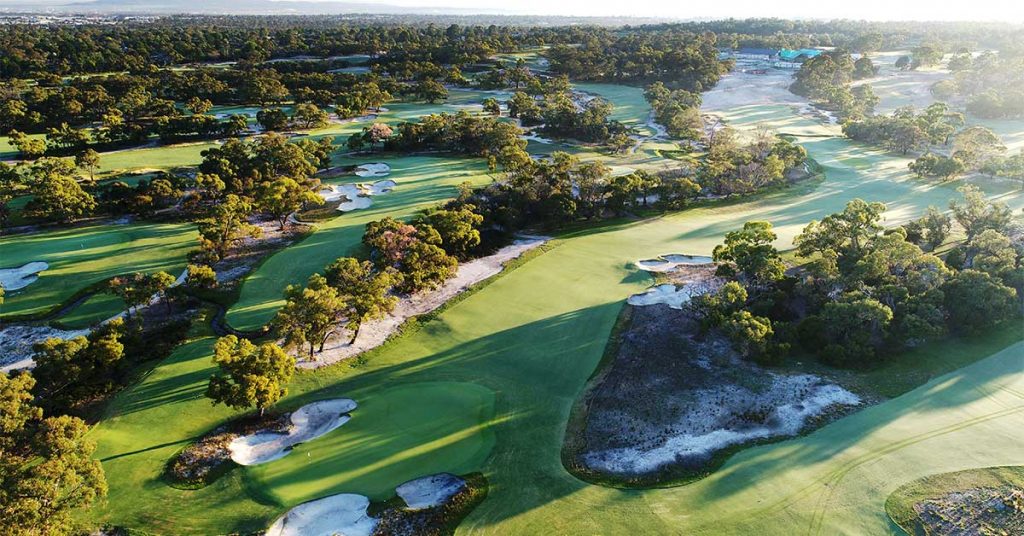PHOTOGRAPHY BY GARY LISBON
Marcus Fraser is not prone to hyperbole, so when he suggests the revamped Peninsula Kingswood Country Golf Club resembles the two highest-ranked courses in the country, you listen intently while your eyes widen.
“It’s the closest thing I’ve played to Royal Melbourne and Kingston Heath, and I think in a couple of years’ time it’ll be in the same conversation,” Fraser says.

High praise indeed for what must rank among the most commendable redesigns in Australia, even though it’s a second renovation of both the North and South courses for the team at Ogilvy Clayton Cocking Mead at the club formerly known as Peninsula. The club’s merger with Kingswood Golf Club – where Corowa-born Fraser spent his formative years – became final in 2013. And the 40-year-old, three-time European Tour winner knows the Peninsula site at Frankston intimately from throughout his golf career.
These days he’s a full member, having been one at Kingswood for more than 20 years. Yet prior to the merger, Peninsula was a place Fraser seemed to find himself visiting regularly thanks to friends being members there, giving him ample qualification to comment on the redesign. And he likes what he sees.

“It’s a pretty special place,” Fraser says. “I don’t think I’ve really seen too many facilities like it anywhere in the world. The quality of the two golf courses then everything else around the clubhouse itself; it’s really second to nothing.”
Two Courses Working As One
Mike Cocking, who along with colleagues Geoff Ogilvy, Mike Clayton and Ashley Mead undertook the redesign project, says there were essential differences between this latest round of changes and their firm’s re-do last decade. The first time, they rebuilt greens, removed excess trees and redesigned all 36 holes in at least a small way, some more successfully than others.
Fast-forward to the time of the merge, and Peninsula was “undergolfed”, according to Cocking, who had previously spent 20 years as a member there. However, the initial motivation was more to do with maintenance than design. OCCM first targeted the greens, which were not uniform and had become soft and ridden with poa annua. Add to this irrigation that needed replacing, drainage issues to address and a re-assessment of the fairway grass, and soon a series of small projects had the potential to quickly become a much larger one.

“The board saw a one-time opportunity,” Cocking recalls. “But by putting all these things together it became a major project. And as we got into it, the board gained more and more confidence. So it kept snowballing.”
Over time the South course had lost its Sandbelt feel and become more parkland in nature. Meanwhile, the North owned what might be the best heathland vegetation on the Sandbelt. Potential oozed from every glorious bank of bracken. “The North is the course a lot of the Sandbelt courses want to be,” Cocking says.
“The North is the course a lot of the Sandbelt courses want to be,” – Mike Cocking
It’s a sentiment that works both ways. One quietly held aim was to bring the best of the Sandbelt to the Frankston site. If OCCM could recreate Royal Melbourne’s greens, Kingston Heath’s bunkering and a level of conditioning Metropolitan would be proud of, it would be the ultimate amalgam. There was no edict to make the two courses inherently different, although subtly it evolved that way. “We were trying to get that last 10 or 20 percent of potential out of the place,” Cocking says.
Aside from the slightly varied landforms, among the differences is the attractive and authentic rock-lined creek winding through the South, which is now a striking and strategic feature. It was reinstated rather than created as the site’s network of creeks dates back to the original layout (then called Tower Golf House) and ran through the course before being piped across fairways and through treelines.
“What started as one creek system on the South became half a dozen,” Cocking says. “The only creeks we were originally going to formalise were on the first and fifth South, but we ended up creating a wetland between the 13th and 15th (on an old creekline) and adding creeks at the 12th, 10th, ninth, sixth, fifth, third, second and first.

“The idea behind the rockwork was to give some structure to help with maintenance but mainly to add an aesthetic feature to give the impression these were old creeklines – like an old ruin.”
While the routing of the pair remains the same, Peninsula Kingswood is, as Fraser says, “a completely different golf course”. Often the best approach for a redesign is not to start from scratch, rather to accentuate the best of what you already have. Accordingly, it’s not the wickedness of the greens or an abundance of any red stakes that is so endearing here. Instead it’s seeing the Sandbelt DNA in the property now take top billing.
One of the great challenges of a 36-hole facility is providing points of difference while ensuring the two 18s complement one another. Fraser says visually the twin layouts look the same but they play differently. The 6,124-metre North is still the premier course – it sits on the superior piece of land – but wearing a tour player’s hat, Fraser says it would struggle to accommodate the crowds for a tournament on its own, whereas the 6,321-metre South is more generous for space.
Intrigue about Peninsula Kingswood has spread via word of mouth rather than a public relations machine. Few images leaked onto social media during the construction process. Yet almost overnight it has become a must-play destination. Fraser says his fellow tour players are inquisitive about it and remain hopeful a tournament can find its way there.
Could it happen? With 36 holes to work with, Fraser sees no reason why not – even if a composite layout needs to be devised to manage crowds and tournament infrastructure. “A lot of the green complexes have amphitheatres around them… so it’d probably be a little bit tricky to get people really close to the greens. But I’m sure they could make it work.”
Geography deprives Peninsula Kingswood of an official place within what is regarded as the famed Melbourne Sandbelt. Yet its location – perfectly situated between the Sandbelt and the Mornington Peninsula – affords it a status all on its own. And with play-and-stay options available for non-members, there’s at least some risk of golfers arriving there and not making it to any other scheduled destinations.
For more information on a Golfing Great head to Visit Victoria.




